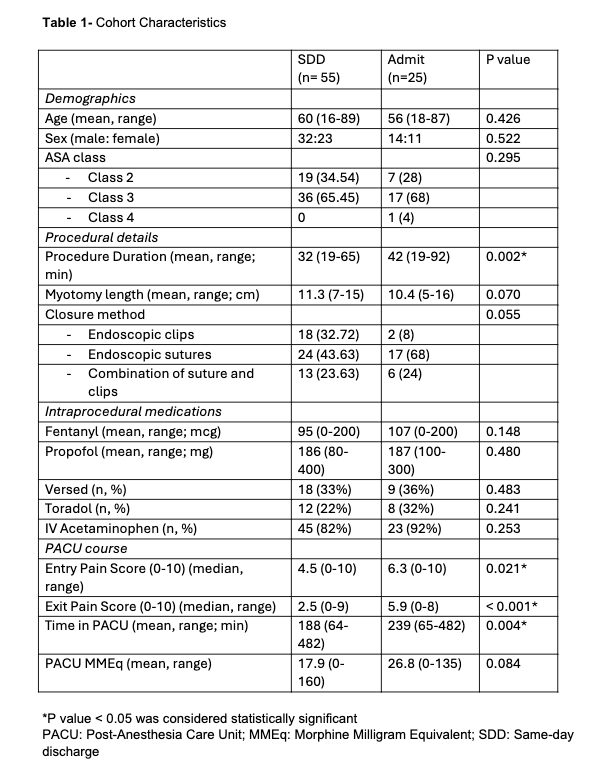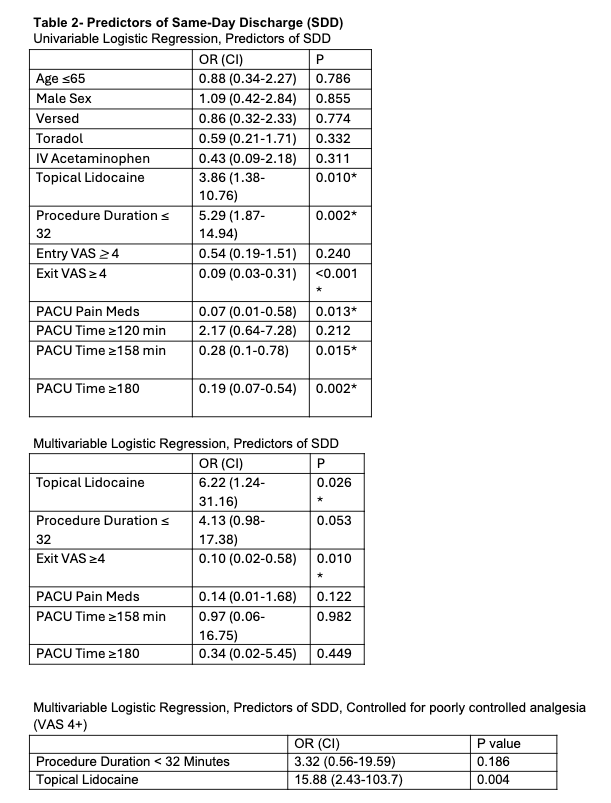Monday Poster Session
Category: Interventional Endoscopy
P3521 - Predictors of Same Day Discharge Following Peroral Endoscopic Myotomy in a Tertiary Care Center
Monday, October 27, 2025
10:30 AM - 4:00 PM PDT
Location: Exhibit Hall
- AS
Apurva Pravin Shrigiriwar, MD
University of Oklahoma Health Sciences Center
Oklahoma City, OK
Presenting Author(s)
Apurva Shrigiriwar, MD1, Christopher Bouvette, MD2, Zainab Rafaqat, MD1, Jalal Gondal, MD1, Michael Ting, 1, Suparshv Parikh, MD1, Ashlee Barr, 1, Alyssa Grossen, MD1, Amir Rumman, MD1
1University of Oklahoma Health Sciences Center, Oklahoma City, OK; 2College of Medicine, University of Oklahoma Health Sciences Center, Oklahoma City, OK
Introduction: Peroral Endoscopy Myotomy (POEM) has revolutionized management of achalasia, with same-day discharge (SDD) gaining interest to reduce healthcare utilizations. However, standardized post-procedural care protocols and discharge timing remain undefined. Our study aims to identify predictive factors of successful SDD.
Methods: This single-center, single-operator retrospective study included patients undergoing esophageal POEM for achalasia between August 2023-April 2025. Multivariate analysis was performed to identify clinical and procedure related predictors of successful SDD.
Results: Eighty patients were included in the study (mean age 58.3, 57.5% male). Baseline characteristics were similar (Table 1). Procedure duration was significantly shorter (32 vs. 42 min, p 0.002) in SDD patients compared to admitted patients. Anesthesia sedation or analgesia requirements were similar across both groups. Patients in the SDD group reported significantly lower pain scores at entry (4.5 vs. 6.3, p 0.021) and exit (2.5 vs. 5.9, p < 0.0001), and had shorter PACU stays (188 vs. 239 mins, p 0.004).
A total of 55 (68.75%) patients were discharged the same day. Among the 25 (31.25%) patients admitted, reasons included postprocedural pain (n=6), pneumonia (n=3), pneumonia and pleural effusion (n-=1), intraprocedural pneumothorax requiring chest tube (n=1), postprocedural pneumothorax (n=1) and observation (n=13). Among SDD patients, five patients made phone calls for pain and two patients visited the ED for the same. One patient reported persistent dysphagia needing EGD. All adverse events were mild, except for one moderate event involving persistent dysphagia requiring repeat EGD.
On univariable analysis, positive predictors of SDD included procedure duration < 32 minutes (OR 5.29, p 0.002) and use of topical lidocaine (OR 3.86, p 0.010). Poorly controlled pain at end of PACU monitoring (visual analog score (VAS) >/= 4) negatively predicted SDD (OR 0.09, p < 0.001). Multivariable modeling confirmed, topical lidocaine (OR 6.22, p 0.026) and VAS >/= 4 (OR 0.1, p 0.010) as independent predictors (Table 2). Upon sub-group analysis of patients with VAS >/= 4, topical lidocaine was the sole predictor of SDD (OR= 15.88, p 0.004).
Discussion: Procedure duration and topical lidocaine use increase the likelihood of discharge, while poor pain control predicts admission. Standardizing lidocaine patches within the perioperative protocol may enhance analgesia management and facilitate safe and efficient discharge.

Figure: Table 1: Cohort characteristics

Figure: Table 2: Predictors of Same-day Discharge
Disclosures:
Apurva Shrigiriwar indicated no relevant financial relationships.
Christopher Bouvette indicated no relevant financial relationships.
Zainab Rafaqat indicated no relevant financial relationships.
Jalal Gondal indicated no relevant financial relationships.
Michael Ting indicated no relevant financial relationships.
Suparshv Parikh indicated no relevant financial relationships.
Ashlee Barr indicated no relevant financial relationships.
Alyssa Grossen indicated no relevant financial relationships.
Amir Rumman indicated no relevant financial relationships.
Apurva Shrigiriwar, MD1, Christopher Bouvette, MD2, Zainab Rafaqat, MD1, Jalal Gondal, MD1, Michael Ting, 1, Suparshv Parikh, MD1, Ashlee Barr, 1, Alyssa Grossen, MD1, Amir Rumman, MD1. P3521 - Predictors of Same Day Discharge Following Peroral Endoscopic Myotomy in a Tertiary Care Center, ACG 2025 Annual Scientific Meeting Abstracts. Phoenix, AZ: American College of Gastroenterology.
1University of Oklahoma Health Sciences Center, Oklahoma City, OK; 2College of Medicine, University of Oklahoma Health Sciences Center, Oklahoma City, OK
Introduction: Peroral Endoscopy Myotomy (POEM) has revolutionized management of achalasia, with same-day discharge (SDD) gaining interest to reduce healthcare utilizations. However, standardized post-procedural care protocols and discharge timing remain undefined. Our study aims to identify predictive factors of successful SDD.
Methods: This single-center, single-operator retrospective study included patients undergoing esophageal POEM for achalasia between August 2023-April 2025. Multivariate analysis was performed to identify clinical and procedure related predictors of successful SDD.
Results: Eighty patients were included in the study (mean age 58.3, 57.5% male). Baseline characteristics were similar (Table 1). Procedure duration was significantly shorter (32 vs. 42 min, p 0.002) in SDD patients compared to admitted patients. Anesthesia sedation or analgesia requirements were similar across both groups. Patients in the SDD group reported significantly lower pain scores at entry (4.5 vs. 6.3, p 0.021) and exit (2.5 vs. 5.9, p < 0.0001), and had shorter PACU stays (188 vs. 239 mins, p 0.004).
A total of 55 (68.75%) patients were discharged the same day. Among the 25 (31.25%) patients admitted, reasons included postprocedural pain (n=6), pneumonia (n=3), pneumonia and pleural effusion (n-=1), intraprocedural pneumothorax requiring chest tube (n=1), postprocedural pneumothorax (n=1) and observation (n=13). Among SDD patients, five patients made phone calls for pain and two patients visited the ED for the same. One patient reported persistent dysphagia needing EGD. All adverse events were mild, except for one moderate event involving persistent dysphagia requiring repeat EGD.
On univariable analysis, positive predictors of SDD included procedure duration < 32 minutes (OR 5.29, p 0.002) and use of topical lidocaine (OR 3.86, p 0.010). Poorly controlled pain at end of PACU monitoring (visual analog score (VAS) >/= 4) negatively predicted SDD (OR 0.09, p < 0.001). Multivariable modeling confirmed, topical lidocaine (OR 6.22, p 0.026) and VAS >/= 4 (OR 0.1, p 0.010) as independent predictors (Table 2). Upon sub-group analysis of patients with VAS >/= 4, topical lidocaine was the sole predictor of SDD (OR= 15.88, p 0.004).
Discussion: Procedure duration and topical lidocaine use increase the likelihood of discharge, while poor pain control predicts admission. Standardizing lidocaine patches within the perioperative protocol may enhance analgesia management and facilitate safe and efficient discharge.

Figure: Table 1: Cohort characteristics

Figure: Table 2: Predictors of Same-day Discharge
Disclosures:
Apurva Shrigiriwar indicated no relevant financial relationships.
Christopher Bouvette indicated no relevant financial relationships.
Zainab Rafaqat indicated no relevant financial relationships.
Jalal Gondal indicated no relevant financial relationships.
Michael Ting indicated no relevant financial relationships.
Suparshv Parikh indicated no relevant financial relationships.
Ashlee Barr indicated no relevant financial relationships.
Alyssa Grossen indicated no relevant financial relationships.
Amir Rumman indicated no relevant financial relationships.
Apurva Shrigiriwar, MD1, Christopher Bouvette, MD2, Zainab Rafaqat, MD1, Jalal Gondal, MD1, Michael Ting, 1, Suparshv Parikh, MD1, Ashlee Barr, 1, Alyssa Grossen, MD1, Amir Rumman, MD1. P3521 - Predictors of Same Day Discharge Following Peroral Endoscopic Myotomy in a Tertiary Care Center, ACG 2025 Annual Scientific Meeting Abstracts. Phoenix, AZ: American College of Gastroenterology.

